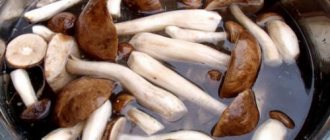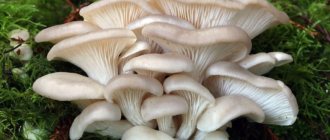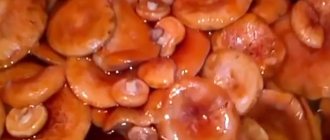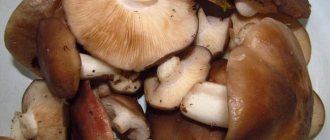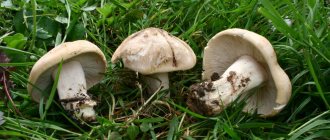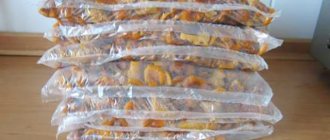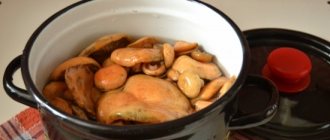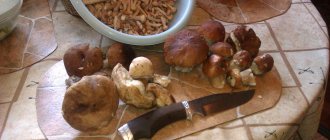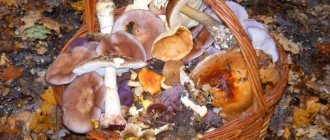One of the most nutritious, easily digestible and aromatic mushrooms, camelina, is loved and in demand on any table; it seems especially tasty if collected with one’s own hands during a long search through the forest thickets.
Dear readers!
For you, we have created communities on social networks in which useful articles and interesting ideas are published several times a day! Subscribe and receive useful content in a convenient format! You can cook saffron milk mushrooms either hot or cold - fry, stew, cook soup, ferment, bake, salt or pickle. The choice of method for preparing mushrooms depends on their quantity and the person’s desire, since saffron milk caps are universal mushrooms.
Is it possible to wash boletus?
There is no need to soak boletus in water before cleaning. The tubular structure of the cap becomes saturated with water, and the mucous film swells, making the cleaning process almost impossible. Fresh wild mushrooms need to be cleaned dry to remove the oily film.
Interesting materials:
How many years of preferential service are required for retirement? How many years do you need to work for warm seniority? How many years of harmful work experience do you need to retire? How long can you store sugar syrup for bees? How much boric acid is needed to spray cucumbers? How many pension points are needed for a normal pension? How much should you run to burn fat? How much protein do you need to gain weight? How long should you hold the abdominal plank? How much FPS do you need for GTA 5?
Are saffron milk caps cleaned?
When deciding whether it is necessary to clean saffron milk caps before cooking, it is worth remembering that this mushroom variety grows in the forest, so there is no need to talk about complete cleanliness of the fruiting bodies. Mushrooms still need minimal cleaning. It is also important not to forget that any crop harvested near highways and industrial enterprises may contain dangerous salts and metals that have managed to be absorbed by mushrooms from the soil. In this case, experts recommend mandatory soaking, although for saffron milk caps it should not be long either.
Each housewife uses her own methods for cleaning saffron milk caps. Some people always soak mushrooms before cooking, while others use the dry cleaning method. In fact, this variety of fruiting bodies is not problematic. Dirt often sticks to the smooth and rather slippery mushroom caps, so debris and dust do not linger on them. In addition, saffron milk caps are not bitter (they do not contain milky juice), so they do not need long soaking. The main accumulations of dirt are located under the cap in the plates, which is why it is these places that should be given special attention.
How to wash saffron milk caps
Most experienced housewives agree that before cooking saffron milk caps, they must be washed. Regardless of what you plan to do with the raw materials in the future (stew, fry or boil), the harvest collected in the forest must be freed from accumulated dirt and microbes. However, any cook knows about the ability of these mushrooms to absorb moisture. Therefore, it is important in the process of cleaning saffron milk caps to adhere to the golden mean: contact of the product with water should not be prolonged.
You can apply a special algorithm for washing the fruiting bodies:
- Cleaning saffron milk caps from sticky leaves using a sponge.
- Trimming damaged areas and cleaning the legs from dirt.
- Rinsing the fruiting bodies under cold running water. It is better to take each mushroom separately for this. This makes it easier to verify the effectiveness of washing and protect raw materials from unnecessary contact with moisture.
Attention! You should not soak the saffron milk caps for more than an hour. The more mushrooms are in water, the more liquid accumulates in them, which negatively affects the quality and taste of the finished product.
How to clean saffron mushrooms
Before you learn how to properly peel saffron mushrooms, you need to remember a number of rules:
- There is no point in delaying the cleaning and processing of fruiting bodies, since the cut crop quickly becomes unusable indoors. In addition to the fact that all their inherent forest aroma evaporates from mushrooms, they can also become dangerous to human health. Therefore, treatment must be started immediately, within the first three hours.
- The cleaning method directly depends on how the saffron milk caps will be used in the future. For example, soaked products are not suitable for drying, so the fruiting bodies must simply be cleaned with a dry sponge. If stewing or pickling is intended, then the harvested crop can be safely washed.
- Experienced mushroom pickers advise starting to clean mushrooms already in the forest. This will save time on home cooking. For cleaning, you only need a sharp knife, which is used to cut off the finds. It is necessary to cut out all problem areas of the mushroom, remove dirt adhering to the stem, and inspect the raw materials for the presence of worms.
Video review of how to clean saffron milk caps before drying or dry salting and what changes occur to the harvested crop during long-term storage:
Dry cleaning process:
- Place the mushrooms in a suitable container and place a bowl nearby to place the cleaned raw materials.
- Inspect each specimen for damage and cut it off if necessary.
- Using a kitchen sponge or toothbrush, remove any adhering dirt, debris and other contaminants from the surface of the cap and its inside. If you can’t do this with dry equipment, you can lightly moisten the sponge in plain water.
- Using a brush or knife, carefully scrape off any remaining soil and other dirt from the stem.
- Inspect the raw materials again for damage and worms.
- Place the cleaned products in a clean container.
LiveInternetLiveInternet
—Categories
- Embroidery (460)
- bargello (7)
- beads (27)
- satin stitch embroidery (21)
- cross (42)
- cross for the kitchen, pillows (63)
- cross landscapes, living (82)
- cross triptych, panels (16)
- cross flowers (84)
- on the grid (2)
- for knitwear (17)
- religion (57)
- lessons, tips (55)
- Crochet (2806)
- crochet accessories (43)
- applications, flowers (139)
- children's accessories (68)
- children's blouses (40)
- socks for children (13)
- children's dresses (42)
- blankets for children (36)
- children's tops (24)
- children's hats (75)
- children's skirts, shorts (72)
- for home (41)
- for kitchen, rugs (431)
- jackets, vests (72)
- Irish lace (36)
- border (107)
- sweaters, pullover (83)
- ribbon lace (11)
- dress, skirts, suits, trousers (167)
- plaid, bedspread (247)
- backpacks (38)
- napkins and more (285)
- bags (263)
- slippers, socks (65)
- top (107)
- patterns (118)
- patterns, motifs (25)
- lessons, MK (132)
- symbols (12)
- car seat covers (3)
- hats, shawls, scarves (153)
- Knitting (6604)
- knitted accessories (10)
- mittens, gloves (231)
- knitted selections (2)
- twos (66)
- for home (83)
- for men (knitting needles, crochet hook) (316)
- jacket (Asia) (227)
- jackets, vests (418)
- jacquard (225)
- border (29)
- cardigan, coat (212)
- blouses (Asia) (273)
- blouses, pullovers (901)
- summer blouses (487)
- missoni (2)
- socks, slippers (401)
- dress, tunic (539)
- top (275)
- patterns (211)
- knitting lessons, MK (340)
- knitting lessons, raglan (127)
- conditional designation (43)
- shawls, stoles (453)
- hats with ears (cats) (44)
- hats, berets (557)
- scarves, snoods (121)
- skirts, suits (175)
- Knitting for children (1772)
- jacket, cardigan (568)
- suits, sets (191)
- blouses, pullovers (521)
- booties, socks (61)
- dress, tunics (116)
- hats, mittens (312)
- skirts (45)
- Horoscopes, zodiac signs, etc. (32)
- Children's page (690)
- audiobooks (11)
- children's creativity (67)
- classes, videos (32)
- modeling (16)
- clothes for dolls, toys (241)
- songs (34)
- preparation for school (65)
- miscellaneous (29)
- drawing (60)
- poems, fairy tales. books (100)
- learn English (6)
- school program (12)
- Color combination (12)
- For computer (32)
- For LIRU (26)
- Women's utilities (47)
- Magazines, books (578)
- audio stories, poems (99)
- knitting Let's Knit Series (50)
- knitting for children (150)
- knitting magazines (155)
- knitting books (106)
- miscellaneous (8)
- garden, vegetable garden (14)
- Winter preparations (475)
- jam. compotes (68)
- mushrooms (62)
- freezing (2)
- cabbage (29)
- other (39)
- salads (160)
- tomato, cucumber, zucchini (106)
- Health (441)
- healthy lifestyle newsletter (2)
- exercises, exercises (54)
- vision (4)
- medicines (28)
- medicinal plants (115)
- folk recipes (141)
- our body (38)
- nebulizer, inhalation (5)
- body cleansing (25)
- healthy products (37)
- Games (18)
- Cooking (981)
- dishes in pots (22)
- dishes in a slow cooker (16)
- cereal dishes (20)
- meat dishes (47)
- vegetable dishes (126)
- poultry dishes (39)
- fish dishes (50)
- unsweetened pastries (90)
- sweet pastries (135)
- Mushrooms, mushrooms (22)
- dessert (5)
- home canned food (36)
- breakfasts (omelettes, sandwiches, etc.) (56)
- healthy food (9)
- recipe collection (8)
- pasta (20)
- drinks (16)
- table decoration, dishes (18)
- dumplings, manti, dumplings (16)
- miscellaneous (25)
- miscellaneous, pickles (54)
- salads, snacks (167)
- soups (31)
- My works (1)
- Music (53)
- Vegetable garden (382)
- video (2)
- cabbage (18)
- potatoes (6)
- bow (59)
- carrots (20)
- cucumber, zucchini (58)
- pepper, eggplant (28)
- fertilizing (2)
- various vegetables (22)
- seedlings (4)
- beets (5)
- tips (101)
- tomato (84)
- Weather (1)
- Crafts, gifts (65)
- Congratulations (8)
- Useful things (97)
- household chores (1)
- Psychology (59)
- Religion (93)
- Handicrafts (309)
- beading (6)
- for home. for family (43)
- rework (49)
- pillows (152)
- usefulness (8)
- bags (31)
- fabric (14)
- fabric+ knitting (8)
- flowers. jewelry made from different materials (4)
- Garden, vegetable garden (411)
- disease and pest control (3)
- garden ideas (93)
- indoor floriculture (37)
- vegetable garden (4)
- fruit trees (49)
- fruit bushes (70)
- garden (30)
- greenhouses, greenhouses (12)
- perennial flowers (53)
- annual flowers (55)
- berries in the country (23)
- Websites (136)
- knitting (64)
- for children (21)
- health (1)
- cooking (1)
- vegetable garden, garden (6)
- handicrafts (2)
- TV, radio (8)
- read (4)
- Color combination (2)
- Links to various topics. (4)
- Poems (249)
- Construction and renovation (66)
- Cozy home (69)
- bathhouse (5)
- family matters (within the law) (29)
- interior (9)
- we make things out of everything (27)
- Movies (102)
- Car covers (12)
- We sew ourselves (289)
- patchwork (92)
- miscellaneous (132)
- tips (41)
- seam care by car (7)
- curtains, sp. set (18)
- This is interesting (35)
We recommend reading: Yogurt How to Store
Is it possible to wash saffron milk caps before salting?
Like many other mushrooms, saffron milk caps can be washed. As mentioned above, the crop should not be exposed to water before dry salting. But at the same time, the products must be thoroughly cleaned. There are also two more options for pickling - hot and cold. The decision whether you need to wash the saffron milk caps depends on the method chosen.
Attention! It is better to use small mushrooms that are not damaged for pickling. Large specimens can only be used if they are strong and intact. Otherwise, the raw material may disintegrate into dust: as a result, the workpiece will not look aesthetically pleasing, which will also affect its taste.
If a cold salting option is chosen, which eliminates heat treatment of the raw materials, the mushrooms must be carefully prepared for the process. This is important to ensure that the finished product does not deteriorate and cause harm to human health.
The cleaning process is as follows:
- The first step is to free the harvested crop from leaves and dirt that have stuck to the fruiting bodies. Particular attention should be paid to the plates on the inside of the cap. Debris can be cleaned off with a damp sponge or cloth. It will be convenient to arm yourself with an old toothbrush for this.
- Then the stem of the mushroom is processed. The lower part must be cut off and the remaining surface cleaned of dirt.
- Place mushrooms in water for 30 minutes.
- Drain the liquid from the saffron milk caps.
- Dilute a salty solution of water, where per 5 liters of liquid there are 3 tbsp. l. salt.
- Place the processed crop in it for an hour so that all the smallest particles of sand, dust and other debris come out of the fruiting bodies.
- Drain the water again.
- Rinse the saffron milk caps under running water.
- Let the raw material drain and dry a little.
Advice! Soaking mushrooms is prohibited in metal containers. It is better to give preference to glass or plastic.
If you plan to carry out hot salting, in which the mushrooms are exposed to heat, then the process of preparing the raw materials looks simpler.
You need to peel saffron milk mushrooms for cooking in this way:
- Remove debris and dirt from the crop.
- Rinse the products.
- Place in an enamel bowl.
- Pour water, add a little salt and citric acid, which will help preserve the natural color of the fruiting bodies.
- Boil for 15 minutes, let drain in a colander.
Important! Cleaning and washing saffron milk caps should be carried out as carefully as possible so that the mushrooms remain intact and do not crumble during processing.
